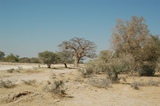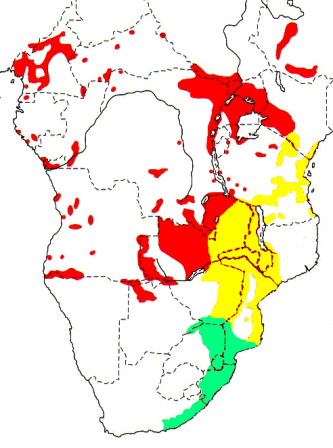Weaver species
Choose different species from drop-down list and press 'Go' button. See Full species list.Spectacled Weaver Ploceus ocularis
IUCN: Least concern Discovery: 034Categories: long tube, , acacias, fruit, frogs, gum, nectar, Nest use, palm, double nests, Ploceus 6: 'Hyphanturgus',
News items about species
Discovery
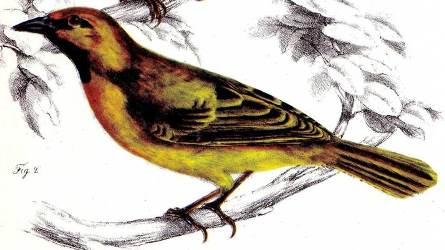
figure from Smith 1839 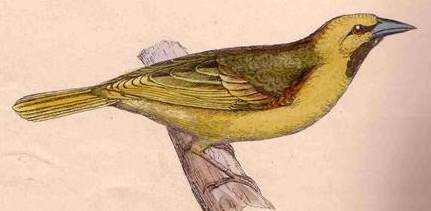
figure from Reichenbach 1863 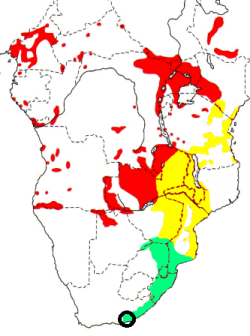
distribution, type locality circled IntroductionThe Spectacled Weaver was formally described by Sir Andrew Smith, a Scottish surgeon, naturalist, explorer and zoologist.Smith lived in South Africa from 1821 to 1837, mainly in Grahamstown and Algoa Bay (i.e. Port Elizabeth) in the Eastern Cape, and in Cape Town in the Western Cape (Kirby 1965). Smith's type-localities are often imprecise because he was more interested in describing ranges than providing formal type-localities. Smith noted that the Spectacled Weaver was 'Found in similar situations with the foregoing', referring to Ploceus personatus = P. velatus for which the locality was given as 'Found in the eastern districts of the Colony'. In Smith (1839) he described it as being 'sparingly distributed over South Africa: more especially in the vicinity of the south-east coast'. Clancey (1952) restricted the type locality to Durban, KwaZulu-Natal, but Smith visited Durban for the first time only in 1832, four years later. Later, Clancey (1964) corrected this to the Eastern Cape and thereafter (1966) selected Grahamstown, Eastern Cape, as a type-locality because Smith was based there in his early years in South Africa. The first illustration of a Spectacled Weaver is a colour painting by George Henry Ford who accompanied Smith later on a trip to the interior of South Africa. The next illustration is by Reichenbach (1863). The nest was illustrated first by Backhouse (1844) (not shown here), showing the nest in the same tree as the nest of a Sociable Weaver - this was artistic licence as these 2 weavers do not overlap in range. Scientific citationPloceus ocularis Smith 1828 S.Afr. Comm. Advert., vol. iii, No. 144, p.2, col. 4; no locality, but = 'eastern districts of the Colony', i.e., eastern Cape. Grahamstown selected as a restricted type-locality by Clancey 1966.Meaning of namesocularis Latin: ocularis, ocular, of the eyes (oculus, the eye).First English nameBlack-lored Weaver-bird (Gurney 1860) - first English name used some 30 years after being described.Alternate namesAbyssinian Spectacled Weaver, Black-lored Weaver-bird, Bottle-nest Weaver, East African Spectacled Weaver, Highland Spectacled Weaver, Smith's Weaver Bird, Uganda Spectacled Weaver.CollectorSir Andrew Smith.Date collectedBetween 1820-1828.Locality collectedThe type-locality was restricted to Grahamstown.Type specimensOne type specimen is in the British Museum (BM 1845.7.6.26). |
The above is based on Weaver Wednesday 2, a weekly series about the discovery of each weaver species.
This species text first appeared as
Weaver Wednesday [151] - Discovery [34]: Spectacled Weaver on 2015-05-06
1. Basic biology
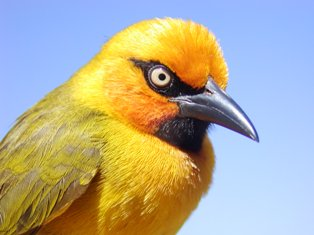
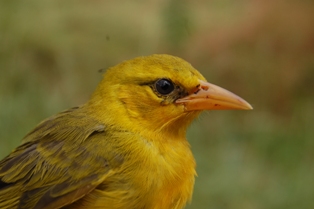
Identification. The Spectacled Weaver Ploceus ocularis is named after the black line running through its eye.
Unlike many other weaver species, Spectacled Weavers have the same bright yellow plumage year round. Sexes are similar but the female lacks the black bib of the male (above left). The juvenile has a pinkish bill, without the eye-stripe initially but can be distinguished from other weavers by its thin bill (above right). See a photo of the female in this pdf on eye colours here (821 kB). The western race of the Black-necked Weaver (see photo birdpix 1064) is very similar in plumage, and the two species overlap in range in Cameroon. Distribution.
Three subspecies of the Spectacled Weaver are currently recognised (see map right, based on Birds of Africa):
Habitat. The Spectacled Weaver is found in open woodland, forest margins, bushy thickets, wooded valleys, along riverine woodland, savanna with sparse trees, and gardens. Food. The Spectacled Weaver is minly insectivorous, including crickets, moth caterpillars, beetle larvae; also spiders, centipedes, small crabs; geckos 3 cm long; berries; whole flowers; and nectar. The typical call while feeding is a characteristic descending series of whistles,'tee-tee-tee-tee".
Breeding. The Spectacled Weaver is a solitary species, probably a permanent pair bond, and pairs often nest at the same site every year. Sometimes nests from previous seasons hang near new nests. The nest is usually built by the male but sometimes the female helps. Unlike polygynous weavers which often build a nest in a day or two, the Spectacled Weaver may take 2-3 weeks to complete its nest. The entrance tunnel is usually 10-20 cm long but may be more than 60 cm long. Nest height varies from 1-7 m above the ground. Egg laying may be as long as two months after the nest is completed. Sometimes a pair will raise two broods in a season - the same nest or a new nest may be used. Beryl Fraser submitted a great sequence of photos of a Spectacled Weaver pair that raised two broods in the same nest - see the PHOWN record here. It is an occasional host of the Diederik Cuckoo Chrysococcyx caprius. The oldest Spectacled Weaver to date was a female recaptured several times up to 12 years 7.5 months later (see here). |
The above is based on Weaver Wednesday, a weekly series about weaver species.
This species text first appeared as
Weaver Wednesday [24]: Spectacled Weaver on 2012-11-28
2. Breeding facts
| Pair bond Monogamous, with long-tem pair-bond Breeding season Dec in Cameroon, Oct in Ethiopia; in DRCongo, Apr-May and Aug-Sept in NE, Sept in S, Jan-Mar in Katanga; Dec-Apr in Rwanda, Feb,Sept (peaks Apr-May and Aug) in Uganda, Aug in Kenya; Jan, Mar, Apr, Jun-Jul and Oct-Nov in Tanzania; Mar and Aug-Sept in Angola, Sept-Mar in Zambia and Malawi, Sept-Nov in N Mozambique and Oct-Apr in S, Sept-Mar in Zimbabwe and Oct-Jan in South Africa Nest site typically suspended from tip of pendulous vegetation, including exotic plants such as Bougainvillea in gardens, 1-7 m (usually 3-4.5 m) above ground, in Okavango Delta (Botswana) attached to side of reed stem, elsewhere suspended from tops of elephant grass, papyrus (Cyperus papyrus) or Phragmites reeds Nest building built by male, watched by female until she adds lining prior to egg-laying, occasionally building shared, or female participates irregularly Colony size Usually solitary, but often builds at same site in successive seasons, with old nests still present; constructs up to four nests close together in one season Clutch size 1-4 eggs, average 2.6 (South Africa) Egg colour white or bluish-green with dull grey or reddish-brown spots, sometimes concentrated at thick end (in South Africa, pinkish ground colour common) Egg size average size of 113 eggs 21.9 x 14.8 mm (South Africa) Incubation incubation by both sexes, sitting very tight (can be captured on nest), nest seldom left unattended, period 13-14 days Chicks and nestling period for first 1-2 days chicks brooded by female and male brings food, thereafter both adults provision young, initially faecal sacs removed by adults, later young defecate down nest-tunnel, nestling period 15-19 days |
Breeding information based on Handbook of the Birds of the World, Vol. 15.
3. Photos of Weaver Nests
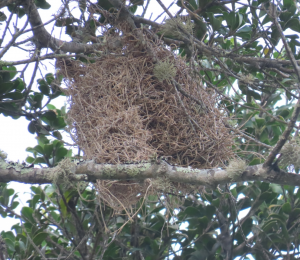 Vm 31068 | 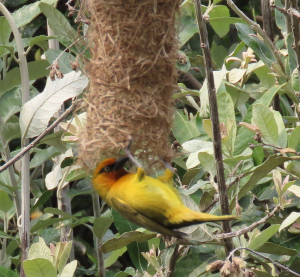 Vm 30919 |  Vm 30723 | 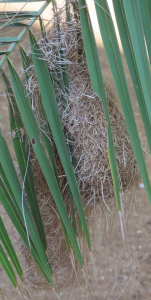 Vm 30662 | 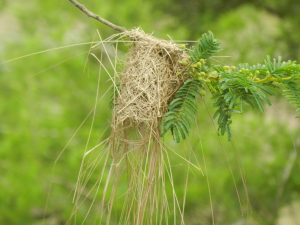 Vm 30327 | 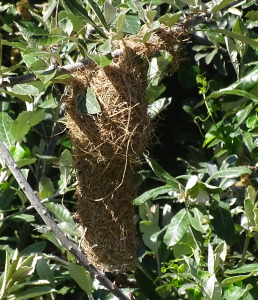 Vm 30234 |
Thumb-nails of most recent PHOWN records - click on one to see its full record
See all PHOWN records for this species here.
PHOWN (Photos of Weaver Nests) provides valuable info on breeding distribution and colony sizes of weavers.
You can contribute by registering and submitting photos at Virtual Museum webpage.
4. Breeding distribution
Google map showing distribution (For species with small ranges you need to zoom in at the correct area to see the range):
yellow blob - range of weaver species; read more about this here.
![]() - PHOWN records with photos
- PHOWN records with photos
![]() - PHOWN records with no photos (Nest Record Cards, other records)
- PHOWN records with no photos (Nest Record Cards, other records)
![]() - Birdpix records
- Birdpix records
![]() - comments on out of range records, or interesting records
- comments on out of range records, or interesting records
![]() - type locality
- type locality
CLICK on the marker on the map to see individual record details.
5. Range changes
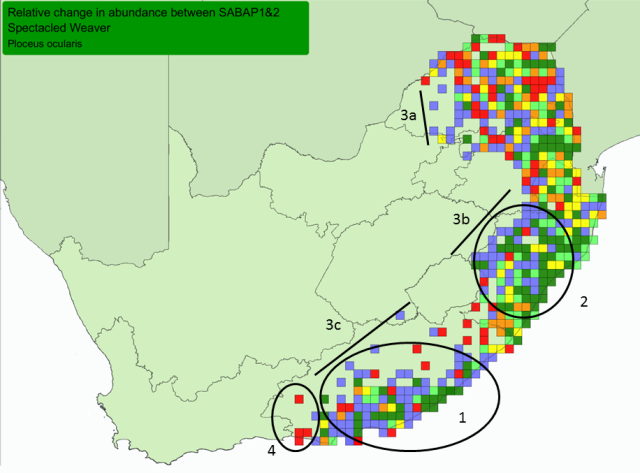
Red, orange and yellow = cells with very large, large, and small relative decreases Blue, dark green and light green = cells with very large, large and small relative increases. Cells = quarter-degree grid cells; Only cells with at least 4 checklists in both SABAP1&2 shown. All cells had this species recorded in SABAP1 or in SABAP2 or in both (more about interpretation at Biodiversity Observations 7.62: 1-13).
Range changes in SA
The points below match the points on the map above. Areas with very large increases include:
Large decreases appear to have occurred:
Range changes elsewhereEquatorial Guinea: at Río Muni, appears to be addition to country list (Demey 2015b). | |||||||||||||||||||||||||||||||||||
The above is based on Weaver Wednesday 3, a weekly series about range changes in South African weaver species.
This species text first appeared as
Weaver Wednesday 3 [243] - Range changes [6]: Spectacled Weaver on 2017-02-08








